英语语法之介词篇
- 格式:docx
- 大小:120.64 KB
- 文档页数:3

介词的常见用法总结介词在英语语法中扮演着重要的角色,用于表达名词、动词或其他词类之间的关系。
在本篇文章中,将总结介词的常见用法并提供相关的例句,以帮助读者更好地理解和运用介词。
一、位置及方向1. 在……之上(on):The book is on the table.(书在桌子上。
)2. 在……之下(under):The cat is under the chair.(猫在椅子下面。
)3. 在……之间(between):The sandwich is between the two plates.(三明治在两个盘子之间。
)4. 在……旁边(beside):She is sitting beside her sister.(她坐在她妹妹旁边。
)5. 在……之内(inside):The keys are inside the drawer.(钥匙在抽屉里。
)6. 在……之外(outside):They are playing outside the house.(他们在屋外玩耍。
)7. 在……之间(among):The book is among the other books on the shelf.(这本书在书架上其他书之间。
)二、时间1. 在……之前(before):I have to finish my homework before dinner.(我必须在晚饭前完成作业。
)2. 在……期间(during):She met her friends during the summer vacation.(她在暑假期间见到了她的朋友们。
)3. 在……之后(after):We usually go for a walk after dinner.(我们通常在晚饭后散步。
)4. 在……时刻(at):The movie starts at 8 o'clock.(电影八点开始。
)5. 在……期望完成的时间(by):He needs to submit the report by tomorrow.(他需要在明天之前提交报告。
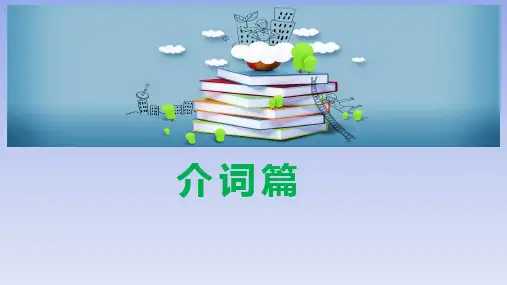

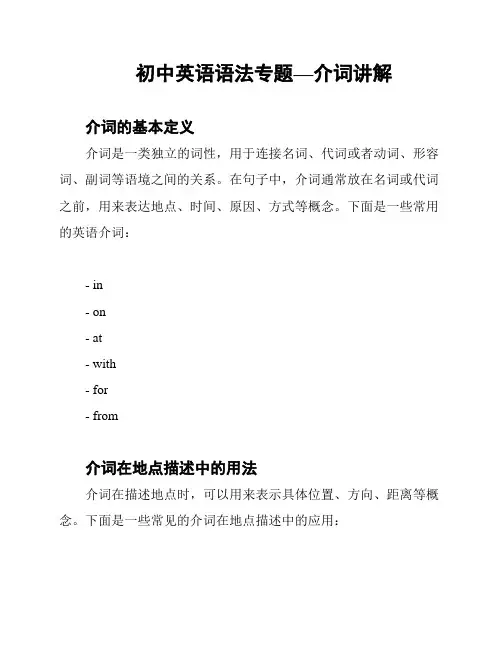
初中英语语法专题—介词讲解介词的基本定义介词是一类独立的词性,用于连接名词、代词或者动词、形容词、副词等语境之间的关系。
在句子中,介词通常放在名词或代词之前,用来表达地点、时间、原因、方式等概念。
下面是一些常用的英语介词:- in- on- at- with- for- from介词在地点描述中的用法介词在描述地点时,可以用来表示具体位置、方向、距离等概念。
下面是一些常见的介词在地点描述中的应用:- in:用于表示在某个范围之内的位置,例如 "in the room"(在房间里),"in the park"(在公园里)。
- on:用于表示在表面、平台或者位置上的状态,例如 "on the table"(在桌子上),"on the bus"(在公交车上)。
- at:用于表示在某个具体位置或者地点,例如 "at the cinema"(在电影院),"at school"(在学校)。
- to:用于表示朝向某个位置的移动,例如 "go to the park"(去公园)。
介词在时间描述中的用法介词在描述时间时,可以用来表示具体时间、时间段等概念。
下面是一些常见的介词在时间描述中的应用:- at:用于表示具体的时间点,例如 "at 7 o'clock"(在7点钟)。
- on:用于表示具体的日期或者星期几,例如 "on Monday"(星期一),"on January 1st"(1月1日)。
- in:用于表示较长的时间段或者某一个时间段内,例如 "inthe morning"(早上),"in July"(在七月)。
介词在原因描述中的用法介词在描述原因时,可以用来表示某事的起因或者原因。

英语语法介词(集锦7篇)英语语法介词第1篇连词概述:连词是一种虚词,用于连接单词,短语或句子,但不单独做句子成分。
按照连词的性质,可将连词分为并列连词和从属连词。
并列连词如:and,but,or,for等,它们即可连接单词,短语,又可连接句子。
从属连词如:when,before ,because等,它们主要引导名词性从句。
常见连词的用法:1)并列连词的用法:并列连词有:and, but, or, nor, so, for yet, however, as well as, both…and, not only…but also, either…or, neither…nor, still,And:连接单词短语句子。
如:Tom and I study in the same But, or :I have a pen but no / Would you like coffee or tea? Nothing but除了,只有: I did nothing but watchOr表示否则:如: Hurry up or you will miss thefor 表示后面的句子是原因。
如: He is good at piano for he practices harder thanNot only…but also 不仅…而且。
可并列主、谓、宾、表及句子。
主语并列时,谓语要就近一致。
如: Not only he but also I am aAs well as 以及,同样。
并列单词、短语、句子。
并列主语时,动词要随前面的主语变化 .如:He works as well as he canEither…or 既…又…,或…或…,并列主、谓、宾、表及状语,如:Either come in or goNeither…nor 既不…也不,并列主、谓、宾、表、状语,并列主语时,谓语就近一致。
如:Neither you nor he isBoth…and 和,既…也,并列主、谓、宾及表语。
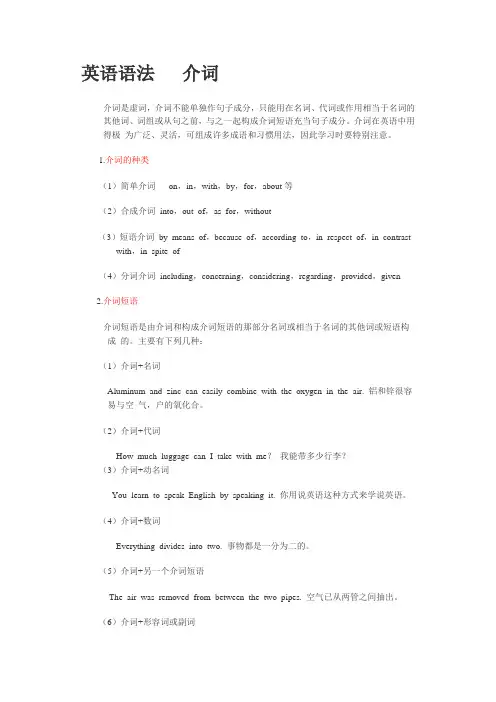
英语语法介词介词是虚词,介词不能单独作句子成分,只能用在名词、代词或作用相当于名词的其他词、词组或从句之前,与之一起构成介词短语充当句子成分。
介词在英语中用得极为广泛、灵活,可组成许多成语和习惯用法,因此学习时要特别注意。
1.介词的种类(1)简单介词on,in,with,by,for,about等(2)合成介词into,out of,as for,without(3)短语介词by means of,because of,according to,in respect of,in contrast with,in spite of(4)分词介词including,concerning,considering,regarding,provided,given2.介词短语介词短语是由介词和构成介词短语的那部分名词或相当于名词的其他词或短语构成的。
主要有下列几种:(1)介词+名词Aluminum and zinc can easily combine with the oxygen in the air. 铝和锌很容易与空气,户的氧化合。
(2)介词+代词How much luggage can I take with me?我能带多少行李?(3)介词+动名词You learn to speak English by speaking it. 你用说英语这种方式来学说英语。
(4)介词+数词Everything divides into two. 事物都是一分为二的。
(5)介词+另一个介词短语The air was removed from between the two pipes. 空气已从两管之间抽出。
(6)介词+形容词或副词It is far from satisfactory.We have made some progress,but it is far from enough.我们已经取得了一些进步,但还远远不够。
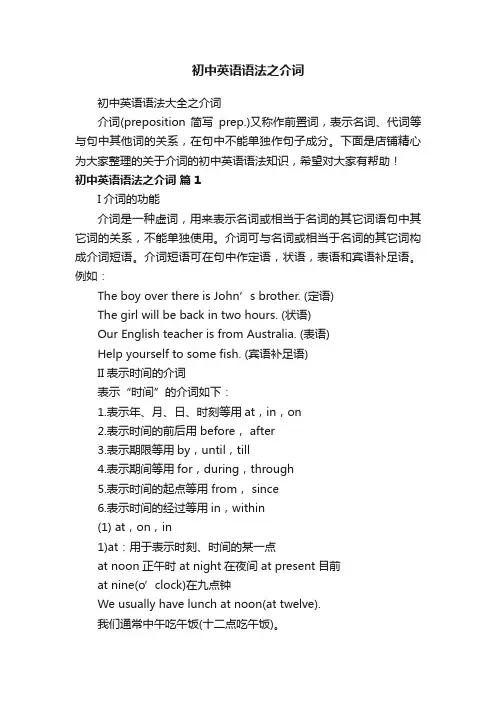
初中英语语法之介词初中英语语法大全之介词介词(preposition 简写prep.)又称作前置词,表示名词、代词等与句中其他词的关系,在句中不能单独作句子成分。
下面是店铺精心为大家整理的关于介词的初中英语语法知识,希望对大家有帮助!初中英语语法之介词篇1I介词的功能介词是一种虚词,用来表示名词或相当于名词的其它词语句中其它词的关系,不能单独使用。
介词可与名词或相当于名词的其它词构成介词短语。
介词短语可在句中作定语,状语,表语和宾语补足语。
例如:The boy over there is John’s brother. (定语)The girl will be back in two hours. (状语)Our English teacher is from Australia. (表语)Help yourself to some fish. (宾语补足语)II表示时间的介词表示“时间”的介词如下:1.表示年、月、日、时刻等用at,in,on2.表示时间的前后用 before, after3.表示期限等用by,until,till4.表示期间等用for,during,through5.表示时间的起点等用 from, since6.表示时间的经过等用in,within(1) at,on,in1)at:用于表示时刻、时间的某一点at noon正午时 at night在夜间 at present目前at nine(o’clock)在九点钟We usually have lunch at noon(at twelve).我们通常中午吃午饭(十二点吃午饭)。
(2)on:用于某天,某一天的上、下午(指具体的某一天时,一律用on)注意 :泛指一般的上午(下午)时用in,但特指某日的上午(下午)时用on。
in the morning在早上on sun day morning在周日早上on Monday在周一on Tuesday morning在周二早上on June 6在6月6日on May 4,1996在1996年5月4日on a cold night在一个寒冷的夜晚on the night of July(the) first在七月一日的夜晚We didn't listen to the lecture on Wednesday afternoon上周三下午我们没去听演讲。
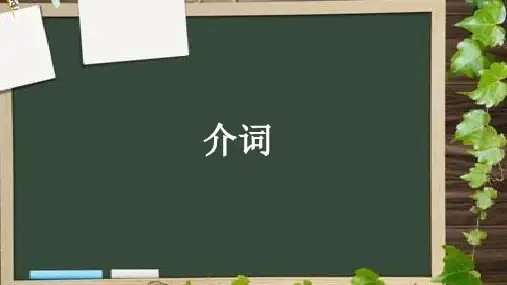
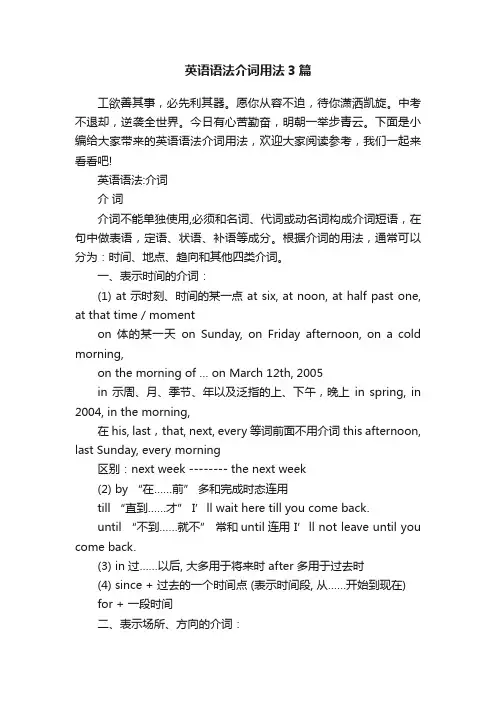
英语语法介词用法3篇工欲善其事,必先利其器。
愿你从容不迫,待你潇洒凯旋。
中考不退却,逆袭全世界。
今日有心苦勤奋,明朝一举步青云。
下面是小编给大家带来的英语语法介词用法,欢迎大家阅读参考,我们一起来看看吧!英语语法:介词介词介词不能单独使用,必须和名词、代词或动名词构成介词短语,在句中做表语,定语、状语、补语等成分。
根据介词的用法,通常可以分为:时间、地点、趋向和其他四类介词。
一、表示时间的介词:(1) at 示时刻、时间的某一点 at six, at noon, at half past one, at that time / momenton 体的某一天on Sunday, on Friday afternoon, on a cold morning,on the morning of … on March 12th, 2005in 示周、月、季节、年以及泛指的上、下午,晚上in spring, in 2004, in the morning,在his, last,that, next, every 等词前面不用介词this afternoon, last Sunday, every morning区别:next week -------- the next week(2) by “在……前” 多和完成时态连用till “直到……才” I’ll wait here till you come back.until “不到……就不” 常和until连用I’ll not leave until you come back.(3) in 过……以后, 大多用于将来时 after 多用于过去时(4) since + 过去的一个时间点 (表示时间段, 从……开始到现在)for + 一段时间二、表示场所、方向的介词:(1)at 表示比较具体的地点 at 37 Renming Roadin 表示比较宽敞的地点 in Renming Street(2)above斜上方-------below斜下方over正上方-------under 正下方on 两物体有接触(3) between…and..在……和……之间 among在……中间(三者以上)(4) across (从物体表面)跨越, 越过 through (从物体中间)穿透, 穿越(5)in 在……里面(表示静止的位置) into 进入,表示运动方向,常用在表示动作的动词之后, 如 go, come, walk, jump, run 等 into的反义词是out of(6)to 到 (目底地)或方向 towards 指朝着某方向,而不是目的地.He walked towards the beach.三、其它介词1.with (1)在一起; (2)有; (3)用某种工具in 用什么材料或语言,或表示衣着,声调特点等by 用......手段2.Like 象......一样as 作为;按照,象......一样(连词)+ 句子3.for(1)为了(表示目的或原因) (2)(后面加一段时间)表示时间段英语中考:介词短语[介词短语聚焦]“介词+名词/代词”所构成的短语称为介词短语。
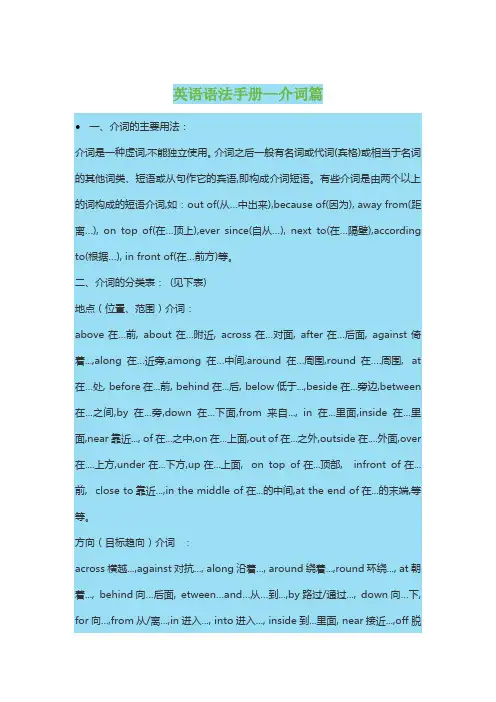
英语语法手册—介词篇一、介词的主要用法:介词是一种虚词,不能独立使用。
介词之后一般有名词或代词(宾格)或相当于名词的其他词类、短语或从句作它的宾语,即构成介词短语。
有些介词是由两个以上的词构成的短语介词,如:out of(从…中出来),because of(因为), away from(距离…), on top of(在…顶上),ever since(自从…), next to(在…隔壁),according to(根据…), in front of(在…前方)等。
二、介词的分类表:(见下表)地点(位置、范围)介词:above在…前, about在…附近, across在…对面, after在…后面, against倚着...,along在…近旁,among在…中间,around在…周围,round在….周围, at 在…处, before在...前, behind在...后, below低于...,beside在...旁边,between 在...之间,by在...旁,down在...下面,from来自..., in在...里面,inside在...里面,near靠近..., of在...之中,on在...上面,out of在...之外,outside在....外面,over 在....上方,under在...下方,up在...上面, on top of在...顶部, infront of在...前, close to靠近...,in the middle of在...的中间,at the end of在...的末端,等等。
方向(目标趋向)介词:across横越...,against对抗..., along沿着..., around绕着...,round环绕..., at朝着..., behind向…后面, etween…and…从…到...,by路过/通过..., down向…下, for向...,from从/离...,in进入..., into进入..., inside到...里面, near接近...,off脱离/除...,on向...上,out of向...外,outside向....外,over跨过..., past经过/超过...,through穿过..., to向/朝...,towards朝着..., on to到...上面,onto到...上面,up向...上,away from远离...时间介词:about大约...,after在…以后,at在…(时刻),before在…以前,by到…为止,during 在…期间,for有…(之久),from从…(时)起, in在(上/下午);在(多久)以后, on在(某日), past过了…(时), since自从…(至今), through 贯穿…(期间), till直到…时, until直到…时, to到(下一时刻), ever since从那时起至今,at the beginning of 在...开始时,at the end of在...末, in the middle of在...当中,at the time of 在...时方式介词:as作为/当作..., by用/由/乘坐/被..., in用…(语言), like与…一样,on骑(车)/徒(步),通过(收音机/电视机), over通过(收音机), through通过...,with用(材料),用(手/脚/耳/眼), without没有…涉及介词:about关于...,except除了…, besides除了…还...for对于/就…而言, in在…(方面), of…的,有关..., on关于/有关..., to对…而言, towards针对...,with就…而言其它介词:[目的介词] for为了..., from防止…, to为了…[原因介词] for因为..., with由于…, because of因为...[比较介词] as与…一样,like象…一样,than比...,to与…相比,unlike与…不同[伴随/状态介词]against和…一起(比赛),at在(上班/休息/上学/家,etc.),in穿着…(衣服/颜色),into变成...,on在(值日),with与…一起,有/带着/长着..., without没有/无/不与…一起三、介词短语的句法作用:介词短语相当于一个形容词或副词,可用作状语、定语和表语。
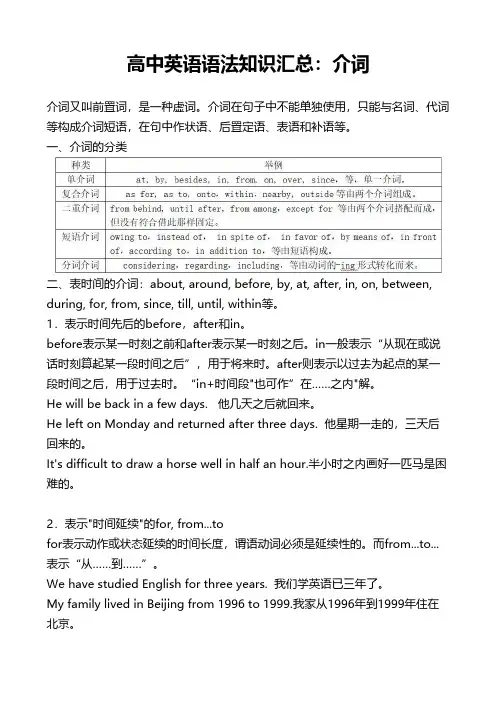
高中英语语法知识汇总:介词介词又叫前置词,是一种虚词。
介词在句子中不能单独使用,只能与名词、代词等构成介词短语,在句中作状语、后置定语、表语和补语等。
一、介词的分类二、表时间的介词:about, around, before, by, at, after, in, on, between, during, for, from, since, till, until, within等。
1.表示时间先后的before,after和in。
before表示某一时刻之前和after表示某一时刻之后。
in一般表示“从现在或说话时刻算起某一段时间之后”,用于将来时。
after则表示以过去为起点的某一段时间之后,用于过去时。
“in+时间段"也可作”在……之内"解。
He will be back in a few days. 他几天之后就回来。
He left on Monday and returned after three days. 他星期一走的,三天后回来的。
It's difficult to draw a horse well in half an hour.半小时之内画好一匹马是困难的。
2.表示"时间延续"的for, from...tofor表示动作或状态延续的时间长度,谓语动词必须是延续性的。
而from...to...表示“从……到……”。
We have studied English for three years. 我们学英语已三年了。
My family lived in Beijing from 1996 to 1999.我家从1996年到1999年住在北京。
3.表示"时限"的介词since, from, by, until(till)since表示动作的起始点,其意是 "从……以来 ",常与完成时态连用。
英语语法大全-介词
介词(Preposition—prep.)
定义置于名词或名词同等语之前组成一个表意单位(短语),用以说明该名词或名词同等语与句子中其他词之关系的词叫做介词(也译作前置词)。
例如:
at,by,in,of,on,to,with,etc.
because of(因为),in front of(在……的前面),etc.
介词之后的名词、代词等叫做介词的宾语,其所组成的表意单位可以如下型式表达:
介词短语在句子中的表达功能如下:
(1)作名词用
A mouse ran out from under the wall.
(有一只老鼠从墙底下跑出来了。
)
解说介词短语“under the wall”在本句中是作其前面的介词“from”的宾语用,因此其功能是等于一个名词,而这样用的介词短语称为名词短语(Noun phrase)
(2)作形容词用
Bring me the book on your desk.
(把你桌子上的那本书拿来给我。
)
解说介词短语“on your desk”在本句中是在修饰名词“book”,因此其功能是等于一个形容词,而这样用的介词短语称为形容词短语(Adjective phrase)。
(3)作副词用
They are studying quietly in the classroom.
(他们正在教室里安静地读书。
)
解说介词短语“in the classroom”在本句中是在修饰动词“are studying”,因此其功能是等于一个副词,而这样用的介词短语称为副词短语(Adverbial phrase)。
介词的总结归纳介词是英语语法中的一项重要内容,它能够描述名词与其他词语之间的关系。
在句子中,介词通常出现在名词或代词前,用以修饰、连接或指示名词与其他成分之间的关系。
为了更好地理解和运用介词,以下是关于介词的总结和归纳。
一、常见的介词及其用法1. in用于表示在某个特定的位置内,如 in the room(在房间内)、in the park(在公园中)等。
还可以用于表示时间、状态、活动等,如 in the morning(在早上)、in trouble(处于困境中)、in singing(在唱歌)等。
2. on用于表示在某个平面或表面上,如 on the table(在桌子上)、on the wall(在墙上)等。
还可以用于表示时间、状态、活动等,如 on Monday(在星期一)、on fire(起火)、on vacation(度假)等。
3. at用于表示在某个具体的位置上,如 at school(在学校)、at the bus stop(在公交车站)等。
还可以用于表示时间、活动等,如 at noon(在中午)、at a party (在派对上)等。
4. to用于表示运动的方向或目的地,如 go to school(去学校)、senda letter to her(给她发信)等。
还可以用于表示时间,如from Monday to Friday(从周一到周五)等。
5. for用于表示目的、原因或受益人,如 buy flowers for her(给她买花)、study for the exam(为了考试而学习)等。
6. with用于表示伴随、一起、使用等,如 go shopping with friends(和朋友一起去购物)、write with a pen(用钢笔写)等。
7. by用于表示通过某种方式或由某人完成某事,如 travel by train(乘火车旅行)、written by Mark(由马克写的)等。
英语语法—-介词Preposition(Prep.)什么是介词(Preposition)?在英语语法中,介词(Preposition)是连接名词、代词、动词或形容词与其他词或短语的一类词汇。
介词用来表示位置、时间、方向、方式、原因等概念。
介词通常放置在名词或代词之前,这种结构被称为介词短语(Prepositional Phrase)。
介词的用法表示方向和位置介词在英语中经常用来表示方向和位置。
以下是常见的方向和位置介词:•in:表示在某个物体或地点之内。
例如:in the room(在房间里);in London(在伦敦)。
•on:表示接触或在某个表面之上。
例如:on the table(在桌子上);on the wall(在墙上)。
•at:表示接触或在某个特定位置。
例如:at the bus stop(在公交车站);at the front(在前方)。
表示时间介词也常用来表示时间。
以下是常见的时间介词:•in:表示在未来的某个特定时间之后或在未来某一段时间内。
例如:in an hour(在一个小时内);in September(在九月)。
•on:表示在某个具体日期或星期几。
例如:on Monday(在星期一);on July 4th(在七月四日)。
•at:表示在某个特定时间点。
例如:at 8 o’clock(在八点钟);at noon(在中午)。
表示方式和原因介词还可以用来表示方式和原因。
以下是常见的方式和原因介词:•by:表示通过某种方式。
例如:go to school by bus(乘坐公交车去学校);learn by doing(通过实际操作学习)。
•with:表示伴随或带有某种特征。
例如:go out with friends(和朋友们一起出去);a house with a garden(带花园的房子)。
•because of:表示因为某个原因。
例如:I couldn’t come because of the rain (因为下雨,我不能来);He failed the exam because of his laziness(因为懒惰,他考试失败了)。
高中英语语法归纳总结介词在高中英语学习中,介词(Preposition)是一个重要的语法知识点。
介词通常用于连接名词、代词、动词或其他词与句子其他成分,起到表示时间、地点、方向、原因、目的等各种关系的作用。
本文将对高中英语语法中常用的介词进行归纳总结,帮助同学们更好地掌握和运用介词。
一、介词的基本概念和分类1. 介词的定义:介词是一类虚词,常由一个或多个字母构成,放在名词、代词或动词等前面,用以表示各种关系,如时间、地点、原因、目的等。
2. 介词的分类:- 时间介词:at, on, in, during, for等。
- 地点介词:in, on, at, by, under等。
- 方向介词:to, from, into, out of, up等。
- 方式介词:with, by, in, without等。
- 原因介词:because of, due to, thanks to等。
- 目的介词:for, to, in order to, so as to等。
二、常用介词用法总结1. 时间介词:- at:用于表示具体的点、时刻或某一天的准确时间,如at 7 o'clock, at noon, at Christmas等。
- in:用于表示较长的时间段、月份、季节、年份等,如in the morning, in May, in winter, in 2022等。
- on:用于表示某一天、日期或具体的星期几,如on Monday, on January 1st, on the weekend等。
- during:用于表示整个时间段或某一时期,如during the summer, during the meeting等。
- for:表示持续的时间段,如for two hours, for a week等。
2. 地点介词:- in:用于表示较大的范围、国家、城市、地区等,如in China, in Beijing, in the classroom等。
英语语法:介词用法介词在英语语法当中是特别常用的一种语法结构,那么作为常用的语法我们该如何学好呢,下面就是我给大家带来的英语语法:介词用法,盼望能关心到大家!介词的用法一:一、介词to的常见用法1.动词+toa)动词+ toadjust to适应,attend to处理;照料,agree to赞同,amount to加起来达,belong to属于,come to达到,drink to为干杯,get to到达,happen to发生在某人身上,hold to紧握,lead to通向,listen to听,occur to想起,object to反对,point to指向,respond to回答,refer to参考;指的是;涉及,reply to回答,see to负责,stick to坚持,turn to求助,write to给某人写信。
b)动词(+sth.)+to+sb.announce to通知某人,describe to向某人描述,explain to向某人解释,express to对某人表达,mention to提及,nod to向某人点头,report to(报告),say to告知,shout to对某人大叫,suggest to对某人提建议,speak to与某人交谈,talk to跟某人谈话,whisper to和某人低声耳语。
c)动词+sth./sb.+ to +sth./sb.add to增加,compare to比作,carry to运输至,devote to致力于,introduce to介绍给,invite to邀请参与,join to连接到,leave to托付给,reduce to下降至,sentence to判处,take to带到。
2. be +形容词/过去分词+ tobe alive to觉察;晓得,be attentive to留意;留心,be awake to知晓,be blind to缺乏眼光,be close to紧挨着,be common to对某人来说很一般,be contrary to违反;反对,be devoted to致力,be deaf to不情愿听,be equal to有的力气,be exposed to暴露;患病,be fair to对公正,be familiar to对某人来说熟识,be grateful to对某人心存感谢,be good to对有好处,be harmful to对有危害,be important to对重要,be kind to友好对待,be known to周知于,be married to嫁给,be moved to转移到,be near to靠近,be necessary to对有必要,be opposite to在对面,be opposed to反对,be pleasant to合某人之意,be proper to专属,be polite to礼貌待人,be rude to粗暴对待,be relative to与有关,be strange to不习惯,be similar to类似,be suitable to适合,be true to忠实,be thankful to感谢,be useful to对有用,be used to习惯。
词法大全(三)-介词
Contents 三大时间介词
三大方位介词
三大交通方式介词
几大易混介词
几个小点
大显身手
介词
介词是一种用来表示词与词, 词与句之间的关系的虚词。
常见介词
at before after in on by to near next to with for under in front of behind from since about
三大时间介词
at on in
↑↑↑
点日剩下
常见的固定搭配:
in the morning/afternoon/evening
at noon/night/midday/midnight
如morning 等有任何词修饰,则用on,如on a cold morning
三大方位介词
in Guangzhou is in the south of Guangdong.
on Sichuan is on the east of Tibet.
to Japan is to the east of China.
三大交通方式介词
by car by plane by train by ship by bike
in my father’s car in a car
on a bike on his bike
几大易混介词
in front of He is sitting in front of me.
in the front of The boy sat in the front of the car.
The boy sat in front of the car. (此句子较离奇)
across 横过She swam across the river.
through 穿过He went through the door.
There are many apples on the tree.
There is a boy in the tree.
树上长的用on,否则用in
几个小点
We arrived in Tokyo at nine.
We arrived at the cinema at nine.
arrive at 用于小地点arrive in 用于大地点
Please answer my question in English.
The woman in red is my teacher.
Look at the man in a hat.
介词后用doing
be good at doing be interested in doing prefer doing to doing thank you for doing
大显身手
1.We decide to go to the Great Wall Saturday morning.
A.to B.in C.with D.on 2.They arrived the village at ten.
A.on B.in C.at D.to 3.Please answer my question English.
A.to B.of C.in D.on 4.He’s swimming the river.
A.along B.across C.through D.over 5.He spends his free time in books during the weekend.
A.read B.reading C.reads D.to read
Thank you your coming.
A.to B.of C.by D.for
Mr Li is going to help him his Chinese this afternoon.
A.with B.on C.by D.at
How much did you pay this book?
A.for B.at C.on D.with
Please fill the bottle tea.
A.by B.with C.for D.in
I prefer coffee tea.
A.over B.to C.for D.than
Help yourself some fish. It tastes very nice.
A.with B.on C.in D.to
I shouted her, but she didn’t hear me.
A.to B.at C.on D.for Keys:DCCBB DAABBDA。